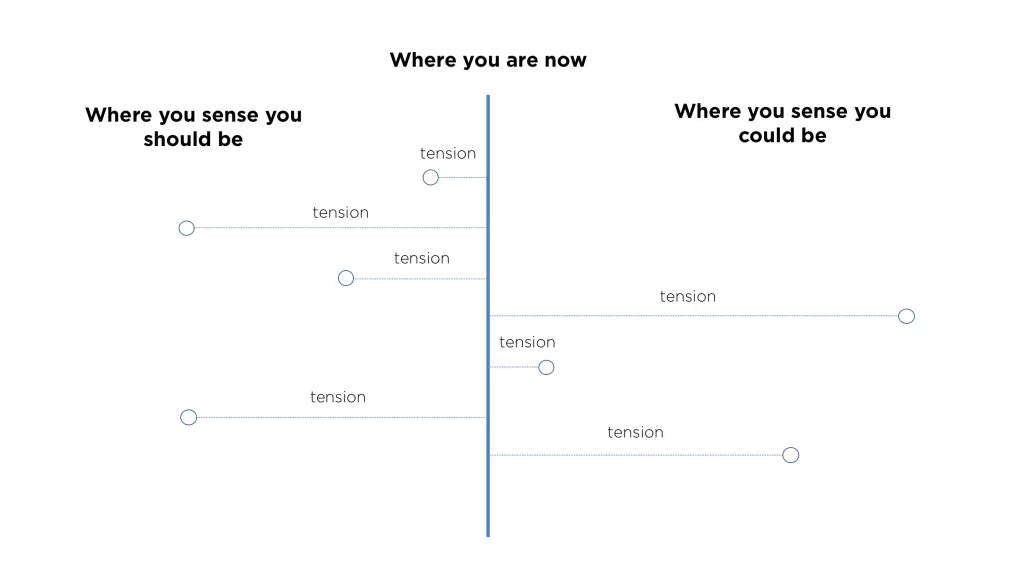Holacracy Basics: Understanding Tensions
You need to understand what a tension is before you can meaningfully interpret how Holacracy really works.
You need to understand what a tension is before you can meaningfully interpret how Holacracy really works.

Tensions pull us towards our potential.
Tensions are the building blocks of Holacracy practice. And just as you need to understand sentences before paragraphs, and words before sentences, you need to understand what a tension is before you can meaningfully interpret how Holacracy really works. So, let’s pick up this thing called “tension,” feel its curves and edges, and figure out what this thing is.
Technically, a tension is the feeling you get when you sense a gap between what is and what could be. More technically the Constitution defines it like this…
You are responsible for monitoring how your Role’s Purpose and Accountabilities are expressed, and comparing that to your vision of their ideal potential expression, to identify gaps between the current reality and a potential you sense (each gap is a “Tension”). Constitution v5 Section 1.2.1
And that’s all the rules say about a tension. That’s it. So, any meaningful interpretation you make of that definition is, technically speaking, perfectly valid. With that in mind, I’m going to share some of my own distinctions. If they help, great. If they confuse you more, just throw them out and go with what makes sense to you.
The world is all gates, all opportunities, strings of tension waiting to be struck.
Ralph Waldo Emerson
The constitutional definition uses the word, “sense” (as in, “…a potential you sense…”) for a reason. It’s because you feel a tension in your body rather than think one only in your mind. That sense may be nothing more than a gut feeling, and in a way, that is kinda the point. Intelligence resides throughout the body not just in the brain (for example, research tells us the gut is particularly smart). So, it’s possible to think something could be a problem, but feel no tension. Like seeing a, “Store Closing” sign for a store you never shopped in. Or if a random stranger suddenly handed you a piece of paper with a math problem scribbled on it. Sure, it’s a problem to solve, but not one you particularly care about.
On the other hand, because sensing is different than thinking, it’s possible to actually feel tension about something you don’t think is a problem — meaning you’re consciously unaware of your own concern (e.g. Bringing up an issue to discuss, but when asked, “What do you need?” just smiling and saying through clenched teeth, “Oh nothing…I just wanted everyone to be aware that this is a very serious issue.”) In the conventional management hierarchy you have limited pathways to process your tensions, so we train ourselves to get good at ignoring problems (or seeming like we don’t care about them). But, you’re a unique sensor for the organization. Which means tensions are inherently human, because only a human can feel them. Another way of saying this is that tensions are based on experience. They aren’t just purely theoretical concerns.
The meaning of the word “tension” tells you nothing about the intensity. A slight annoyance. A catastrophic disaster. Both are tensions. So, basically a tension is anything other than a completely neutral feeling. And this is important to understand because, by definition, we don’t usually even notice things about which we feel absolutely nothing. “The sky is blue.” “That chair is brown.” These statements don’t spark any feeling. That’s neutral. That’s zero energy. And absolute neutrality is our starting point. Pretty much anything other than that feeling is a tension and even the slightest pull toward or push away counts. And if you’re thinking that’s a low bar, you’re right.
In conventional organizations, the system usually can’t digest tensions very well, so it makes sense to keep them from ever getting into the system in the first place. So, feeling frustrated about something? Try to keep it to yourself. See a new opportunity? Don’t burden the system unless you’re sure others are bought in. In fact, only bring things up if everyone agrees it’s important. But that approach won’t work going forward — and it can feel very weird in meetings if you’re looking for consensus on a decision you have the full authority to make. Since others can easily bring their own agenda items and process their own tensions, trust them to do so.

It’s common to think of “a tension” as “a problem,” but there are two issues with that. First, as described above, a tension can be anything — even something incredibly positive. You may feel excitement or smell opportunity and those are still tensions. Remember, a tension is defined as a gap between the way things are now and a potential you sense, and that could be making something incredibly awesome even better.
The second reason why tensions aren’t problems (or it’s not helpful to think of them as problems), is because tensions signal problems — they aren’t themselves the problem. They may be uncomfortable or inconvenient, or even painful. But ignoring tension is like unplugging a fire alarm just to stop the beeping. In doing so, you’ve dealt with the signal…not the problem. This is why we talk about “processing” tension rather than “eliminating,” tension. Tensions are really just signals of something else (and without getting too philosophical, I’d call that something else, “potential.”) So, take your tensions seriously, because they’re telling you to pay attention to something.
Your suffering is truth; it is intelligent.
Chogyam Trungpa
So, tensions aren’t really problems. Or at least they aren’t exclusively problems. So, when a facilitator solicits items for an agenda, which is just a list of tensions, consider anything you need to talk about, inquire about, or figure out is a tension.
Note: It’s common to say tensions are “solved,” as in, “Would that solve your tension?” and since “solved” refers to “solutions,” then it’s easy to assume that a tension is akin to a “problem.” The language isn’t helping us here. Conceptually, the ideal word would be “closed,” as in closing a gap (e.g. “Did that close your tension?”).
Processing a tension may result in some organizational change, sure, but it could also mean I just gain more information about the issue. Nothing changes at all. I just learned more. It’s not like a problem gets solved, it’s more like you become aware the problem never existed. In this way, new information can act like a solvent. It can eliminate tension even if nothing changes.
If you step on a snake you’ll feel fear. But if you suddenly recognized, “Oh, it’s just some rope,” your fear would disappear. You didn’t kill the snake. You didn’t run from it. You didn’t do anything except disabuse yourself of the oh-crap-that’s-a-snake-illusion. That’s what I mean by information can literally make tensions disappear.
So, before jumping in to change things, sometimes you just need to consider the possibility that you just aren’t seeing the whole picture. Practically speaking, you’ll likely need to get into the habit of seeking information even more than you do already.
Clarifying questions are a reliable way to gain perspective, but equally effective is clarifying your reaction may be based on missing data; e.g. “This seems like a horrible idea — but maybe I’m missing something.” Or, “Look, I’m owning my tension — but I don’t want to feel it anymore — so maybe if I just understood more of where you are coming from, that might resolve it.”
And I don’t mean you shouldn’t. I mean you can’t. By definition. Sure, it may seem like two people feel the same tension, but it’s like two people having the same virus. They are distinct illnesses because they are in different bodies. So, for example, we know that curing one doesn’t automatically cure the other.
This is why the constitution says you can’t process tensions on behalf of other roles (unless you’ve been given permission) because, you just simply can’t feel someone else’s tension. And this isn’t about being selfish and not helping each other, it’s about recognizing that everyone has roles to play and if we’re habitually processing tensions on behalf of other roles, then whose processing tensions for your roles? It’s would be like the goalie always leaving his post to help the defenseman.
This is why in Holacracy, “help” isn’t impulsively embraced with unbridled enthusiasm (for more on “help” in Holacracy, read Our Inner Gangster). There is something else we need. We need to honor boundaries. If I came home and found my neighbor cleaning my kitchen, I’d be totally weirded out.
Knowing it’s not possible to feel someone else’s tension explains why you can’t object to proposals in governance meetings on behalf of other roles (unless given permission from that role), and why Rep Links aren’t just dumb conduits for your tension — you actually need to “infect” them with the tension.
Processing tensions one-at-a-time is one of the most important disciplines of real-world Holacracy practice. It shows up in meetings where we mechanically process agenda items one-at-a-time, but it also generally informs how the rest of Holacracy is intended to work.

The usual assumption is that groups, if they like and respect each other, have little need for formal discipline. The group will figure it out (which typically means, “the loudest wins”). But there are two problems with this. First, is this thing called, “the group.” While a tension can be felt by a group, it still needs individuals to feel it. Meaning even if a group feels tension, we’d still have to ask, “Which specific individuals feel a version of the group’s tension?”
The second problem is equating “natural” with “good.” Sure, natural foods are healthier, but we still need personal trainers to make us exercise and alarm clocks to wake up. Processing one-tension-at-a-time takes discipline. It’s hard. We are built for novelty and excitement, not careful attention to detail. Taking turns is something we have to work at.
So, remember this the next time a Facilitator tests your objection. Or when they tell you to add your own agenda item. Or when they tell you your clarifying question sounds like a reaction. They aren’t saying your perspective isn’t important — they’re just saying it’s not your turn.
Tensions aren’t of any particular size or shape. They can be made up of other tensions. They are fibrous. Flexible. Morphable. Meaning, sometimes a tension is a pattern. Sometimes what seemed like a small thing is actually a big thing. After all, you can’t understand an avalanche just by looking at each snowflake.
So, trying to process as “a pattern of events” is totally fine. But, two things to watch for. First, don’t forget the specifics. Tensions are based on experience, not theory (see #1), so be prepared to describe some examples of the pattern. Second, just because tensions can be patterns, doesn’t mean you should always process them as such. This is important to remember when you’re having trouble processing a tension. Maybe, for whatever reason, it’s just too big to process. Like when the governance proposal you’re making has too many moving parts, or if you’re having trouble making progress on a particular project.
Sometimes tensions can be broken down into smaller, more digestable bits. Remember, all you need is one small step forward. Just get clear on that one next step, or just make a simple starting proposal. And trust that you’ll have plenty of opportunities to help things evolve. Just because there is a pattern at play, doesn’t mean you need to resolve the whole pattern all at once. Maybe you just need to resolve some of its contributing factors.
Read “Introducing the Holacracy Practitioner Guide” to find more articles.
To learn more about self-management, join a community of pioneers and check out our e-courses → Self-Management Accelerator
